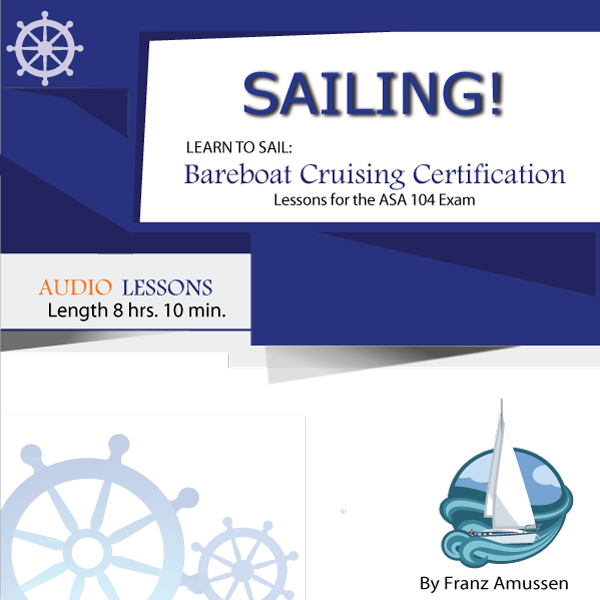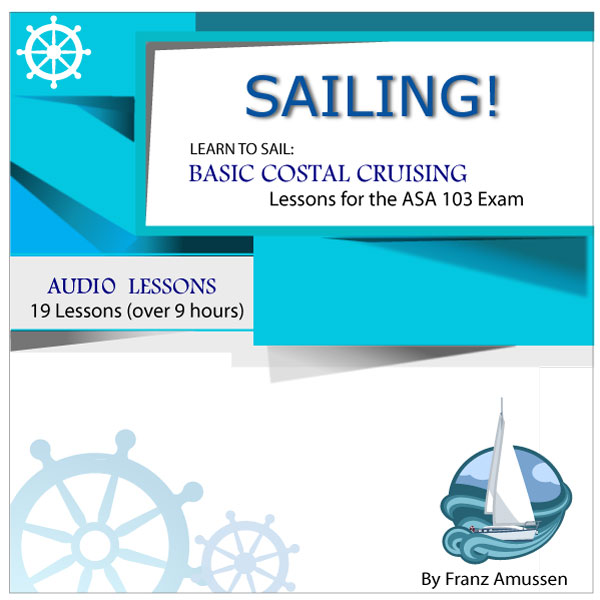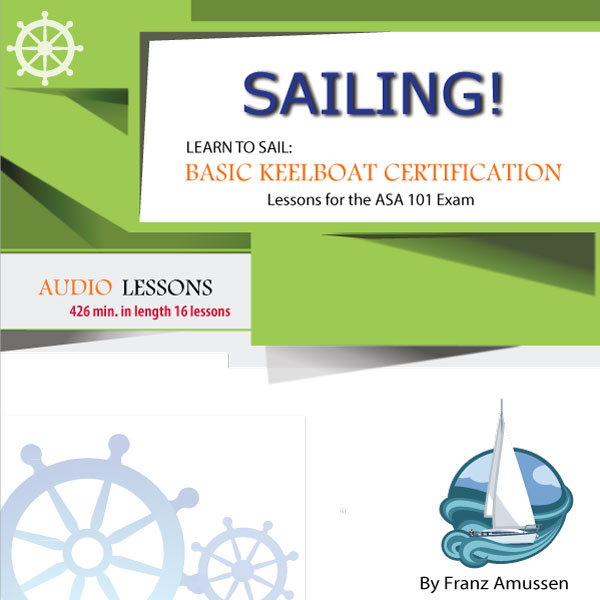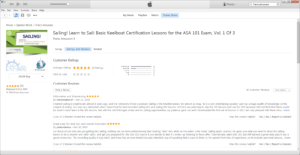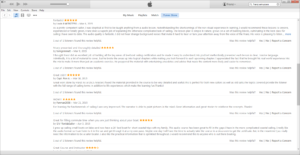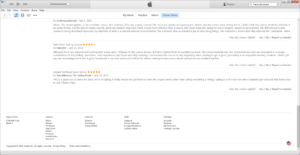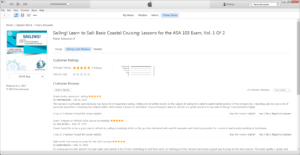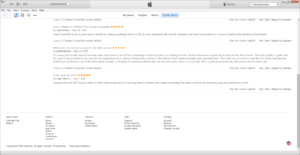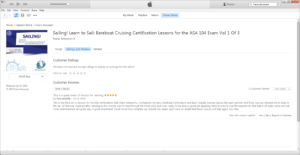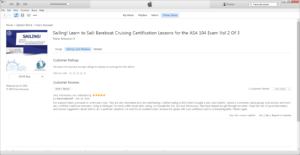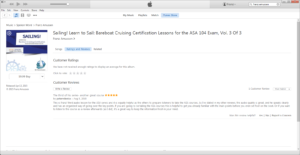Learn to Sail audio lessons!
Learn to sail!
I put together a series of learn to sail audio lessons to help current sailors and future sailors prepare for the ASA 101 the ASA 103 and the ASA 104 exams. If you are just starting out and want to learn to sail I recommend that you start out by listening to the Basic Keelboat Certification Lessons(ASA 101). It will start out by teaching you the parts of a boat and basic maneuvers as well as what is required to pass the written portion of the ASA 101 exam. I try to make all these lessons interesting by peppering the lessons with real world anecdotes of my experiences to try to reinforce the lessons
Bareboat Cruising Certification (ASA 104)
Sailing! Learn To Sail: Bareboat Cruising Certification Lessons for the ASA 104 Exam
Lesson Description:
8 hrs 10 min of Audio Instruction
Lesson 1:
Describe appropriate clothing and personal gear to pack for safety and comfort during a one -week cruise.
Describe the required documents and procedures for customs and immigration when cruising to a foreign port of entry.
Lesson 2:
Plan a menu and create a provisioning list for a one-week cruise.
Lesson 3:
Describe the symptoms and first aid treatments for hypothermia and heat exhaustion / heat stroke.
Lesson 4:
Describe the causes, prevention and treatments for seasickness.
Lesson 5:
Describe the tools and spare parts that should be on board for a one-week cruise.
Lesson 6:
Determine the fuel tank capacity of the training vessel, describe variables that affect range under power, and calculate the range based on average fuel consumption.
Lesson 7:
Determine the fresh water capacity of the training vessel. Describe the minimum daily water requirements for all personnel on board and methods to conserve fresh water.
Lesson 8:
Describe safe galley procedures to minimize the danger of fire, scalding, spillage, etc.
Lesson 9:
Describe proper marine toilet operation, including precautions to prevent malfunction.
Lesson 10:
Describe proper holding tank pump-out procedures
Lesson 11:
Describe safe fresh water tank filling procedures, including identification of correct deck fills and cautions to be observed near a pump-out station.
Lesson 12:
Describe power conservation measures and procedures to prevent running batteries down when anchored/moored overnight.
Lesson 13.
Name four acceptable distress signals, as listed in the Navigation Rules, which are appropriate for a recreational vessel.
Describe actions to be taken in the following situations:
Collision with another boat
Running aground
Dragging Anchor
Flooding
Lesson 14:
Describe actions to be taken in the following situations when the vessel is under power:
Fouled Propeller
Engine cooling water fails to flow
Engine fails in a crowded anchorage where using sails is not possible
Engine fails in a busy channel
Lesson 15:
Describe the information required and the procedure for tying a boat to a fixed dock in areas with a large tidal range.
Lesson 16: Describe the following multiple-anchor mooring procedures and their purposes:
Fore & Aft Moor (bow and stern anchors)
Forked Moor (two anchors set 45 to 90 degrees apart at the bow)
Bahamian Moor (two anchors set 180 degrees apart at the bow)
Mediterranean Moor (anchor set off the bow with stern to a dock)
Lesson 17:
Describe methods and potential dangers of:
Rafting vessels at anchor.
Describe safe methods for towing and securing a dinghy / tender.
Describe preparation of the vessel for heavy weather sailing including gear stowage, crew safety and appropriate sail plan.
Lesson 18:
Describe the following courtesies and customs:
Permission to board
Permission to come alongside
Courtesy in crossing adjacent boats when rafted
Rights of first boat in an anchorage
Keeping clear of regattas
Flag etiquette
Rendering assistance to vessels in distress
Lesson 19:
Describe and apply Rules 1 through 19 from Navigation Rules, International – Inland.
Lesson 20:
Explain and identify the following coastal navigation terms, using a chart or diagrams as appropriate:
Speed
Time
Distance
Tidal Range
Tidal Current
Track Course
Heading
Bearing
Line of Position (LOP)
Fix
TrueMagnetic
Variation
Deviation
Lesson 21:
Describe the sea breeze and land breeze effects.
Identify conditions that may lead to the formation of radiation and sea / advection fog.
Describe actions to be taken in the following weather situations:
Fog / reduced visibility
Heavy squall
Lesson 22:
Perform the duties of skipper and crew on a live-aboard coastal cruise of at least 48 hours
Locate and check the condition of all federally required equipment.
Perform a routine vessel inspection, ensuring that all systems and equipment are in working order, including:
fuel level
fresh water level
battery voltage
electrical system
navigation lights
instruments and electronics
bilge through-hulls and seacocks
standing rigging
running rigging
deck hardware
ground tackle
Visually inspect the auxiliary engine. Check for correct engine oil level and potential problems such as leaking fluids or frayed belts.
Inspect the raw water strainer for debris and ensure that the raw water intake seacock is in the proper position for engine operation.
Locate the emergency steering tiller and identify where it attaches to the rudder post.
Operate the electric and manual bilge pumps to ensure they are functional.
Demonstrate proper usage of the VHF radio, including hailing another station on Channel 16 and switching to a working channel.
Demonstrate proper operation of the galley stove including fuel supply, lighting, and shutting down. Simulate the proper way to extinguish a galley fire.
Demonstrate the proper method of disconnecting and reconnecting shore power cables.
Lesson 23:
Demonstrate the use of spring lines in the docking/undocking process (e.g., pivoting the vessel away from the dock during departure).
Maneuver the vessel in reverse gear, observing and explaining the effect of prop walk on the stern’s direction.
Maneuver the boat in a confined space to include performing ‘standing turn’ maneuver, turning the vessel 180 degrees in a confined area using rudder position and gearshift / throttle control.
Ensure vessel / crew readiness and use the auxiliary engine to bring the vessel smoothly and under control to a stop next to a parallel dock or into a slip; secure the vessel using appropriate lines and fenders
Describe / demonstrate an appropriate crew overboard recovery method while under power. Describe methods to bring COB safely back onboard.
Demonstrate one of the following multiple-anchor mooring methods as appropriate to local conditions, using correct procedures such as hand signals, safety in handling ground tackle, proper operation of windlass (if equipped) and use of a snubber or bridle. Raise anchors and get underway smoothly using correct procedures.
Fore and Aft Moor
Forked Moor
Bahamian Moor
Mediterranean Moor
Sail a compass course (+/- 10 degrees) with sails trimmed properly.
Demonstrate the proper usage of all lines and sail controls (halyards, sheets, traveler, boom vang, outhaul, jibsheet fairleads) that are available on the training vessel to obtain maximum performance and comfort.
Demonstrate the correct usage of a jibe preventer.
Demonstrate proper reefing procedures (jiffy reefing or in-mast furling as appropriate for the training vessel) while under sail or hove-to.
Demonstrate two appropriate crew overboard recovery methods while under sail; options include the Quick-Stop, Figure-8 and Broad Reach/Close Reach methods. Begin from both close-hauled and a broad reach and select the most appropriate maneuver for the initial point of sail.
Plan a coastal passage from origin to destination, plotting courses, distances, and waypoints. While en route, keep a log and a DR plot and calculate estimated times of arrival (ETA) to waypoints.
Obtain and interpret marine weather information; describe the impact that the present observations and forecast may have on sailing plans over the next three days.
Update weather forecasts during your passage, verify through visual and measured observations.
Take visual 2 or 3-bearing fixes using a hand-bearing compass.
Determine the predicted depth above or below chart datum at a given time using tide prediction tables.
Use a GPS / chartplotter (if so equipped) to obtain information and perform basic navigation functions such as position, course, speed, waypoints, ETA, and tidal information.
Pilot a boat into an unfamiliar harbor or anchorage by day using relevant nautical charts, publications and tidal information.
Knots
Describe the purpose of and construct each of the following knots (without assistance and in a timely manner):
Figure-8 Knot
Clove Hitch
Round Turn & 2 Half Hitches
Cleat Hitch
Bowline
Sheet Bend
Rolling Hitch
Trucker’s Hitch
Basic Cruising Certification (ASA 103)
Sailing! Learn to Sail: Basic Coastal Cruising: Lessons for the ASA 103
19 lessons Over 9 Hours of Instruction
Here are the links to purchase through ITunes (2 volumes)
Table of Content
Lesson 1: Cruising Sailboat Terminology
Lesson 2: Safety Equipment & Procedures
Lesson 3 Safe Refueling Procedures, Essential Navigators Tools, Nautical Chart and Symbols, Latitude and Longitude, Depth Soundings, True and Magnetic North
Lesson 4: Dangers of and How to Avoid a Lee Shore, Sources of Weather Information
Lesson 5: How to Interpret Marine Weather Information, Small Craft Advisories, Gale Warnings, How to Identify Cumulonimbus Clouds and their Dangers
Lesson 6: Impact Weather Forecasts may have on sailing plans for the next 6 -12 hours, How to Reef or Reduce Sail Area, Planning a Sail Based on Weather, How to Heave to, Skipper and Crew Responsibilities
Lesson 7: More Comments on Heaving To, Rules of the Road 6,8 and 8
Lesson 8: Navigation Rules for Sailing Vessels Rules 12, 13, 14, 15, 17
Lesson 9: Vessel Navigation Lights, Operating a Vessel in Restricted Visibility
Lesson 10: Whistle Signals
Lesson 11: How to Anchor and “Diver Down’ and ‘Alpha’ flags
Lesson 12: Stages of Hypothermia and Treatment, Methods for Getting a Person out of the Water and Safely Back on Board, Fires and Extinguishers.
Lesson 13: What if Scenarios: Cabin Filling with Water, Engine Failure,
Lesson 14: What if Scenarios: Failed Steering System, Fouled Propeller
Lesson 15: What if Scenarios: Rig Failure, Dragging Anchor
Lesson 16: What if Scenarios: Grounding at Anchor, Running Aground Under Sail
Lesson 17: On the water Part 1
Lesson 18: On the water Part 2
Lesson 19: On the water Part 2
Basic Keelboat Certification (ASA 101) is now ready it consists of 16 lessons totaling 7 hours and 6 minutes of audio instruction
Sailing! Learn to Sail: Basic Keelboat Certification
Lessons for the ASA 101 exam
Course Content
Customer Reviews and Comments
I’ve listened to most of Franz’s podcasts and thoroughly enjoy the point of view, experience, guests, and the non-sailing stories as well. Since I have gotten so much from the free podcasts, when I decided to sign up for 101 and 103 I purchased the audio. I’m a huge audible fan so this is right up my alley. My fiance Lisa and I listened to your course twice, did some online sample tests, and watched some training videos on Amazon. Well, we took the exam today, Lisa got a 91 and I got a 92. I think Franz’s audio played a big part in our success. He adds many personal experiences helping to make sense of a very foreign language. I had sailed once years ago and Lisa had never sailed. We are doing the 103 over the next 2 days and I am listening to that audio class as I type this. I give the 101 audio 2 thumbs up. Pros: Real life experiences, Franz has a comfortable, easy to listen to voice, very thorough. Cons: Some of Franz’s personal vocabulary is intermixed, which I don’t mind, but there is already much confusion to a newbie. That said, well worth the money. Keep up the great work. Review by Tom Wolfe
*****
I found the 103 audio even more helpful than the 101. I scored a 96 on the exam and am looking forward to February to take the 104, 105, and the 114. I signed up with San Juan sailing after hearing them on your podcast. I let them know how I found out about them. Thanks Franz! Review by Tom Wolfe
****
Franz, I am a fan of the podcast and want to let you know that the ASA 101 lessons are really helping my girlfriend Brandy learn all the proper terms on the boat. Instead of calling everything this Thingy and that Thingy, she now is using the right terms, most of the time. We listen together in the car and discuss how it relates to our boat, a MacGregor 26M.
I have also learned a few things I never knew even though I grew up sailing and racing. Sailing is a lot more fun with a hot girl on board that knows how to sail!
We started a new sailing podcast a few months ago called The Sailing Rode, you can find it on iTunes and Stitcher, or our website TheSailingRode.com. I plan to mention your lessons on an upcoming podcast and explain how they are helping Brandy. We put the link in the show notes. I will let you know when we post the podcast.
I have a new appreciation for the work it takes to produce a podcast. Thanks for keeping yours going. We are also producing sailing videos of our adventures, I must be a glutton for punishment as they take about 25 hours to produce a 15min video. But it is fun work and we will always have them to look back. Here is the latest video: https://youtu.be/FaU3YNzd5OA
I am sure we will buy the other programs when we make it through the 101. Thanks for putting them together. I also put a review up on iTunes for them.
Fair winds, Steve
****
Reviews from Amazon
****
These audio lessons are the best thing for a novice sailor since a roller furling jib. If don’t know a roller furling jib from a jibe. Then you need these lessons. Seriously not only does the author do a great job explaining the parts of a boat, sailing terms and getting you ready to pass the ASA exams. He keeps you entertained with his real life experiences. So much so, I’d bet even the most experienced sailor will enjoy having a set.
I listen to them on my daily commute. They make the time fly by. The topper is. He has a website, from there you can send him messages. I had a question and he responded with the answer the same day. Great sailor, great communicator, great guy! I can’t wait for the next release.
Hope to see you on the water,
Lew
I have enjoyed Franz’s Sailing in the Mediterranean podcast for almost as long as I’ve been sailing, so when I heard about his ASA 101 lessons, I had to check them out. They were the perfect thing to get me through the dark, cold Michigan winter. franz has a very easygoing style and presents these lessons almost as though he was telling stories about his sailing trips.
But the lessons aren’t just entertaining. They are carefully organized and full of the information beginning sailors need to know and more experienced sailors ought to review. I’m beginning my fourth summer of sailing, and I’ve already completed the 101, but I still found the lessons well worth my money. (Unfortunately I didn’t get in on Franz’s giveaway, but I’m glad to write a review for him anyway.)
If you are looking for audio sailing lessons, these are very informative and fun to listen to.

(Note: This review applies to the complete course, all 3 volumes.) This was a great course! The instructor speaks at a good pace, clearly, and has a nice voice. Going into it, I didn’t think this course would be effective in an audio format, but the lack of visuals and the great descriptions may have made it even more effective than a course with visual materials! Being forced to imagine, based on descriptions, the different parts and scenarios being described improved my retention of what is a massive amount of information. The instructor does a wonderful job of describing things.
The instructor’s stories also help improve the “learnability” of this course, because after you learn a concept, the instructor will walk through a real-life situation involving that concept, providing a good review and context for the lessons. My critiques are limited and minor, and likely personal to me: Sometimes the digressions went on a bit too long, and shortening some of them up could help shorten up the class overall, which would be a good benefit, since the audio course is about the same length as the in-person courses I’ve found. I also found the “whistle” lesson difficult, because the instructor dives into “whistle conversations” before laying out in details what each whistle means. Finally, I was sometimes unclear on what information was actually required for the course, and what was being taught simply because it’s good information to have, but not required for the certification.
My final praise for this item is that I enjoy having it in an audio format, as it’s easy to go back and refer to it when I have questions. (And I don’t have to keep around bulky books or paper to do so.) This is a great course, and after listening through once and reviewing a few things for a second time, I feel well prepared for the exam.
My husband was one of the people who took Franz up on his offer to receive the pod casts free in exchange for an honest review. I am helping him with the review, so it is a combination of both of our opinions from my stand point.
I am a power boater and have only been learning to sail out of love for my husband of 8 years. Very slowly has he been teaching me, as he has been teaching himself with the help of books, a friend, and hands on. He is wanting to get more serious about sailing and wants to get certified, which means that I need to know how to sail too. I find sailing very enjoyable, but I get frustrated, as it doesn’t come as natural to me as I would like.
I do not enjoy reading and need to be taught by real people, Franz has been a good teacher. I am learning a lot. Every now and then I feel he is a little to basic, and then he throws in something I have never heard of. My husband enjoys the side stories about real events, I do as well, but sometimes it throws me off because I am not as comfortable with all the terms.
Franz is easy to listen to, If I can listen to him anyone can. He has a lot of experience and seems to know exactly what to do to prepare you for the test without boring you to death. My husband has listened to almost all of the lessons as well as his other pod casts and enjoys him very much. Time will tell when the test comes. Although I have taken the some of the sample tests in the ASA book and have done well after listening to Franz.
If you are looking for audio lessons, you have found the right one.
There are also a few tips and tricks Franz throws in that, while not directly pertaining to the class, are still very helpful. The dual anchoring technique was brilliant!
If you prefer to purchase it in ITunes here are the links (2 volumes):
Introduction
This is a 7 hour 6 minute: 16 lesson audio course designed to help you prepare for the Basic Keelboat Certification exam conducted by the American Sailing Association, the ASA exams are basically the same material covered in the other exams such as the US Sailing Association and the British Royal Yachting Association with one big difference in Europe and for the most case, most of the rest of the world outside north America, the lateral aids to navigation are red left returning from the sea.
We cover terminology, definitions, and commands, different names of components on a sail boat. We learn about Rules of the Road, Lateral aids to navigation, man overboard recovery drills, boating pollution rules, required safety equipment, and really all that can be covered an audio course for this basic exam.
While it is obvious we can’t cover the actual on the water exam we do discuss what is expected and what your thought process might be when taking the practical sailing on the water exam.
The author, producer, narrator is Franz Amussen the host of Sailing in the Mediterranean Podcast (medsailor.com) with over 30 years of sailing experience, both in racing and cruising.. He spends at least 2 months each year sailing aboard his Lyle Hess designed Bristol Channel Cutter usually in the Mediterranean also he sails or charters with friends in other locations too numerous to list.
Lesson 1
This lesson is the beginning of our understanding of the terminology of the science and sport of sailing. In this lesson we discuss the meaning and definition of the following terms:
Hull
The measurement of the boat in displacement, net registered tons and gross registered tons)
length waterline, length overall, length on deck, draft, Beam, free board, stringers and bulkheads
Transom
Keel (Full, Fin, Modified)
Ballast
Bow (forward)
Stern (aft)
Rudder (rudder post, aft hung, skeg)
Pintle’s and Gudgeon’s
Helm
Tiller
Wheel
Theoretical maximum speed of a displacement hull
Lesson 2
In this lesson we continue our understanding and learning about the terminology of sailing.
Deck
Stanchion
Lifeline
Pulpit
Mast and mizzen mast
Boom
Gooseneck, Outhaul, Vang, Preventer,
Standing Rigging
Stays, forestay, Backstay, Running Backstay, Shrouds, turnbuckles were rigging screws, chain plates,
Bowsprit, Whisker stays, Bob stay
Running Rigging
Main Sheet, Jib Sheet, Staysail Sheet,
Halyards, Main, Jib etc.
Parts of the Sail
Head, Tack, Clew
Leach, Luff, Foot
Lesson 3
In this lesson we continue our understanding and learning about the terminology of sailing.
Hanking on a mainsail
Sail Track
Boom Track
Bolt Rope or sail slides
Jib and Genoa
Hanking on an Jib
Bolt rope or Hanks (plastic or Bronze)
Jib Tracks (Foil)
Roller Furling
Reducing sail area on a jib
Roller furling
Roller furling is a method of furling or reefing a sail by rolling it around a stay or rotating spar. Roller furling is most prominent on foresails such as jibs, followed by mainsails.
Cleats
In nautical contexts, a cleat is a device for securing a rope.[2]
Types of cleat designs include the following:
A horn cleat is the traditional design, featuring two “horns” extending parallel to the deck or the axis of the spar, attached to a flat surface or a spar, and resembling an anvil.
A cam cleat in which one or two spring-loaded cams pinch the rope, allowing the rope to be adjusted easily, and quickly released when under load.
A jam cleat in which the line is pinched in a v-shaped slot.
A clam cleat (or jam cleat) in which the rope is held between two fluted stationary pieces. Such a cleat vaguely resembles two halves of a clam shell held back to back. It is more compact than a cam cleat, but the rope is less easily released under load.
A cleat hitch is a knot used to secure a rope to a cleat.
Lesson 4
In this lesson we continue our understanding and learning about the terminology of sailing.
Cockpit
Cabin
Fender
Dock lines
Painter
Blocks
Traveler
Telltales
Heel
Skipper
Master
Helmsman
Crew:
Helmsman / Skipper
Tactician
Maintrimmer
Port Trimmer
Starboard Trimmer
Pitman
Bowman
Weather Helm
Ahead
Astern
Abeam
Lesson 5:
Heel
Tacking
Starboard Tack
Port Tack
Wind Vane at top pf Mast
Apparent Wind
True Wind
Jibing
No-Sail-Zone
Close Hauled
Close Reach
Beam Reach
Broad Reach
Run
Sailing-by-the-Lee
Luffing
In Irons
Head-to-Wind
Comands and crew Responses
Heading Up
Bearing Away
Ready About –Ready—Helms a-Lee (or Coming About or Tacking)
Prepare to Jibe—Ready—Jibe-Ho (or Jibing)
Lesson 6:
Navigation Rules Part 1
Stand On Vessel and Give way Vessel
Rules of the road Starboard vs Port Rule, Rule 12(A)(i)
Rule 12 – Sailing Vessels
Overtaking Rule 13
Rule 13 – Overtaking
Power vessel approaching head on Rule 14
International Rule
Inland Rule
Lesson 7:
Navigation Rules Part 2
How to determine if you are on a collision course!
Rule 15 – Crossing Situation
Rule 17- Action by Stand-on Vessel Return to the top of the page
Danger Signal 5 blasts
RULE 2 Responsibility
RULE 5 Look-out
RULE 6 Safe Speed
RULE 7 Risk of Collision
RULE 9 Narrow Channels
RULE 10 Traffic Separation Schemes
Lesson 8:
Navigational Aids
Identify and state purpose of Lateral Aids to Navigation
Color
Numbering
Returning
Left side Even Numbered
Right Side Even Numbered
Preferred channel markers
Preferred-Channel Aids
Identify Safe Water Markers
Safe Water Marks
Regulatory Markers
Identifying Regulatory Markers
Regulatory or informational markers are used to advise you of situations, dangers, or directions. They may indicate shoals, swim areas, speed zones, etc. They can be easily identified by the orange bands on the top and bottom of each buoy.
Location Markers
Diamond-Shaped Dayboards
Range Dayboards
————————————–
Extra
International Rules IALA
International Association of Lighthouse Authorities.
Red Left Returning
Cardinal Marks
Cardinal Marks are used in conjunction with the compass to indicate the direction from the mark in which the deepest navigable water lies, to draw attention to a bend, junction or fork in a channel, or to mark the end of a shoal.
Mariners will be safe if they pass North of a North mark, South of a South mark, East of an East mark and West of a West mark. Cardinal Marks are also used for permanent wreck marking whereby North, East, South and West Cardinal buoys are placed around the wreck. In the case of a new wreck, any one of the Cardinal buoys may be duplicated and fixed with a Radar Beacon (RACON).
At night, the lights of Cardinal Marks are programmed with distinct identifying characters; as an aide memoire they can be considered to flash in accordance with positions on a clock face whereby an East Cardinal flashes 3 times, a South Cardinal 6 times (but with an added long flash to make it more distinctive) and a West Cardinal 9 times. The North Cardinal doesn’t quite fit the pattern – having a continuous quick or very quick flash.
The buoy illustration shows Class Two configurations of buoys. These are approximately 3 meters in diameter and weigh approximately 6 tons excluding moorings. Buoys are needed to be recognized both in daylight and at night and use ‘Top Marks’ to assist in identification. A Top Mark on a Cardinal Buoy is triangular and colored black. Top Marks and buoy colors themselves are arranged in order to represent the points on a compass.
http://www.trinityhouse.co.uk/lighthouses/buoys/cardinal.html
US Memory aids
Red, Right, Returning
-used when navigating in a channel
Green, Right, Going
-used when navigating in a channel
Do you have any red port left?
-the port (left) side of the boat has red lights
Red over Red, Captain Is Dead
-vessel not under command
White over Red, Pilot Ahead
-pilot vessel on duty
Red over Green, Sailing Machine
-optional sailing vessel lights
Red over Red over Red = Rudder Rubbing Rocks
-vessel constrained by draft – international rules
Red over Red over Red, big F*%&#in vessel ahead
-vessel constrained by draft – international rules
Green over White, Trawling Tonight
-fishing boat towing nets
Red over White, Fishing Boat Light
-general fishing lights (not trawling)
Lesson 9:
Safety Gear and Procedures
List the federally required equipment for a recreational sailboat of 25 feet in length
Lesson 10:
Lights, float plan, alcohol, reporting accidents, oil pollution and trash
Identify the location and color of navigational lights used by a recreation vessel of 25 feet in length
Describe the purpose of a float plan, give examples of information contained therein and to whom it would be submitted
Describe when and to whom boating accidents must be reported
Describe the federal blood alcohol content (BAC) limit for vessel operation
Describe proper means of waste disposal including penalties for improper disposal and means for Notification
Trash:
Oil
Lead-Acid Batteries
Lesson 11:
Whistle Signals
International and Inland Whistle signals
Lesson 12:
Registration or Documentation
Hull Numbers
Registration Numbers
Documentation Numbers
Describe under what circumstances an operator must render assistance to another boater in danger.
Boat Capacity Plates
Describe the information an operator should acquire before operating his/her boat in an unfamiliar area.
Lesson 13:
Anchors and Anchoring, types and techniques
Anchor Rhode
Scope
Types of bottom and holding
Lesson 14:
How to trailer an launch a boat
Moring a boat!
Spring/ Breast Lines
Fairlead vs padeye
5 Situations which one may be considered negligent as a boater
Getting ready to leave the dock
What do you do?
Lesson 15:
Man overboard ideas and procedures
Lesson 16:
Proper Clothing
Knots you need to know:
Bowline (king of knots)
Reefing knot (Square Knot)
Figure 8 (Stopper)
Half Hitch
2 half Hitches
Clove Hitch
Cleat Hitch
Round Turn and 2 half Hitches
Leaving the dock
The on the water test ideas and thoughts for preparation

